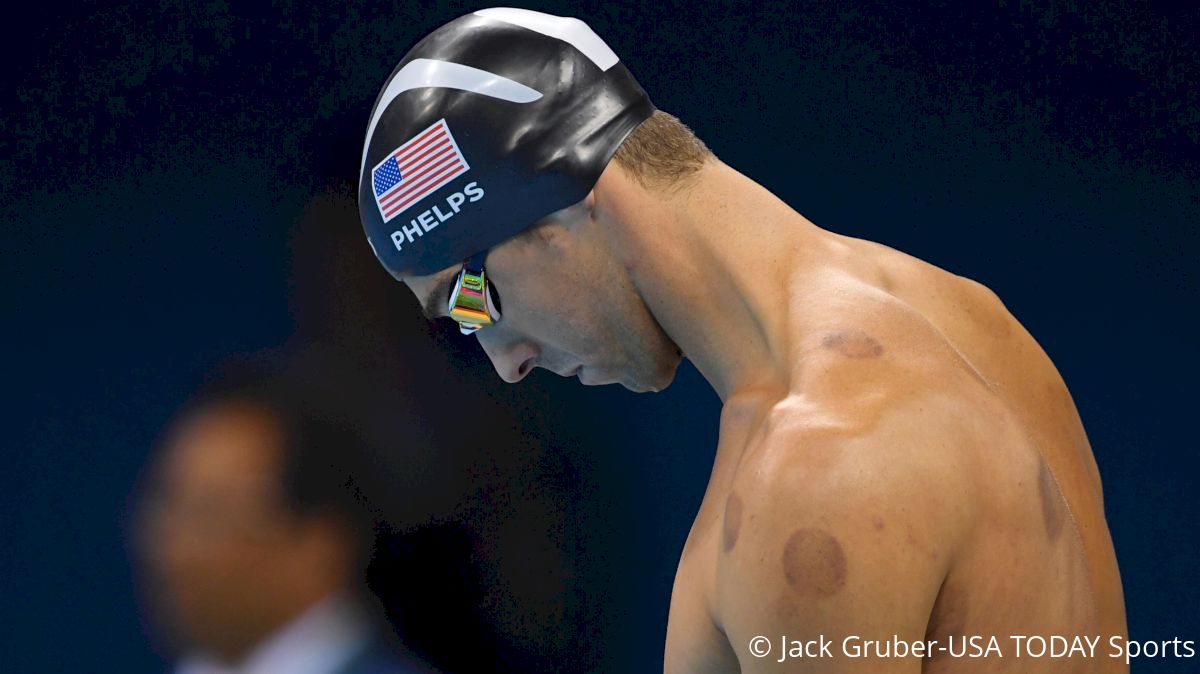Cupping: Does It Really Accelerate Recovery?
Cupping: Does It Really Accelerate Recovery?
Anthony Ashley, swimmer for University of Missouri, talks with an athletic trainer about the cupping technique for swimmers. He discusses the theoretical and practical uses of cupping for muscle recovery in swimming.

If you watch any high-level championship meet, you are sure to see large, dark, purple dots lining the shoulders and backs of some swimmers. If you are like my own parents and have no idea what causes these marks, you might guess the swimmer got into an altercation with a rather large octopus or decided to get an interesting minimalist tattoo.
Unfortunately, the reality is not nearly so exciting. Those dark purple dots are bruises, a side effect of an increasingly popular recovery tool, cupping.
Cupping is a type of muscle therapy. A small cup, either glass or plastic, will be placed on a certain muscle in an athlete's body. Then, either through suction or heat, a vacuum is created that stretches the muscles or tissue to reduce knots and soreness.
There is some debate about the effectiveness of cupping athletes. Many medical professionals maintain the belief that there is no actual benefit to the therapy. Despite this, athletes and swimmers around the world at the highest level of competition take advantage of the practice.
Justin Gawlik, the athletic trainer for the University of Missouri's swim team, has been cupping his athletes for years, and he is one of many collegiate swimming trainers across the country to utilize it. After cupping hundreds of athletes, he said he has only had one athlete who did not feel the benefits.
Cupping traditionally comes from Asia and has been used for hundreds of years as a form of alternative medicine. It was first adopted into the U.S. by schools on the West Coast according to Gawlik. He attributes the recent growth in popularity to the Olympics and athletes such as Michael Phelps being seen with the distinctive bruises.
Although he knows the value of the treatment, Gawlik is suspicious about some requests for cupping.
"99.9 percent of the time I think they're sore," Gawlik said. "But there are times when I think a swimmer just wants to go to the meet and look like Michael Phelps."
Cupping can be used both in the middle of the season and towards taper. Gawlik said cupping is used during the season to dig someone out of the hole and allow them to recover when swimming and weightlifting are most intense. During taper, cupping is utilized to make sure the muscles remain loose and improve blood flow according to Gawlik.
--
Unfortunately, the reality is not nearly so exciting. Those dark purple dots are bruises, a side effect of an increasingly popular recovery tool, cupping.
What is cupping?
Cupping is a type of muscle therapy. A small cup, either glass or plastic, will be placed on a certain muscle in an athlete's body. Then, either through suction or heat, a vacuum is created that stretches the muscles or tissue to reduce knots and soreness. There is some debate about the effectiveness of cupping athletes. Many medical professionals maintain the belief that there is no actual benefit to the therapy. Despite this, athletes and swimmers around the world at the highest level of competition take advantage of the practice.
Justin Gawlik, the athletic trainer for the University of Missouri's swim team, has been cupping his athletes for years, and he is one of many collegiate swimming trainers across the country to utilize it. After cupping hundreds of athletes, he said he has only had one athlete who did not feel the benefits.
Where did cupping come from?
Cupping traditionally comes from Asia and has been used for hundreds of years as a form of alternative medicine. It was first adopted into the U.S. by schools on the West Coast according to Gawlik. He attributes the recent growth in popularity to the Olympics and athletes such as Michael Phelps being seen with the distinctive bruises.Why use cupping?
Cupping is a valuable tool to provide manual therapy with ease and without a reliance on a trainer's hands according to Gawlik. Like other forms of manual therapy, cupping stretches and loosens the muscles allowing an athlete to recover and continue to train at a high level.Although he knows the value of the treatment, Gawlik is suspicious about some requests for cupping.
"99.9 percent of the time I think they're sore," Gawlik said. "But there are times when I think a swimmer just wants to go to the meet and look like Michael Phelps."
When do you use cupping?
Cupping can be used both in the middle of the season and towards taper. Gawlik said cupping is used during the season to dig someone out of the hole and allow them to recover when swimming and weightlifting are most intense. During taper, cupping is utilized to make sure the muscles remain loose and improve blood flow according to Gawlik.--